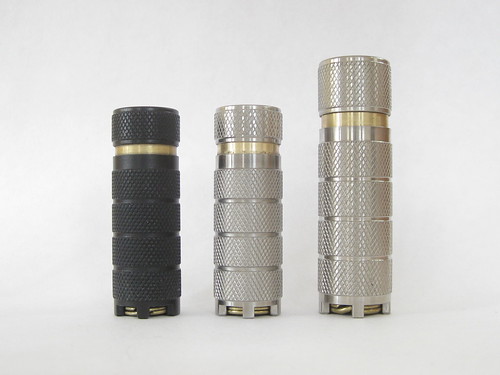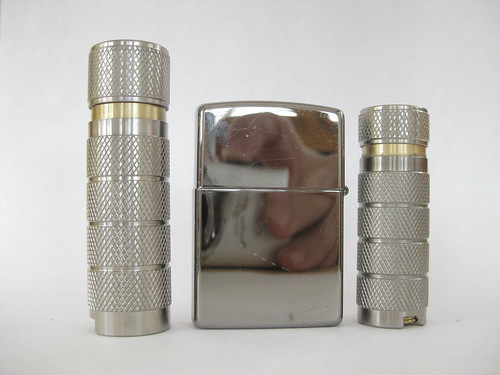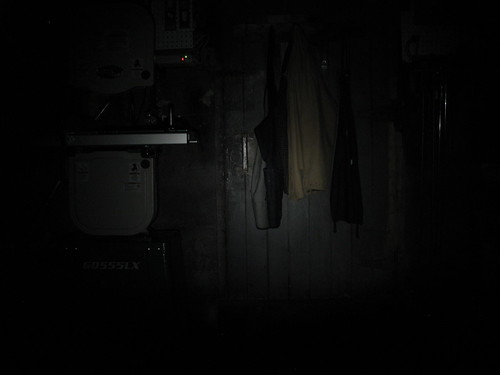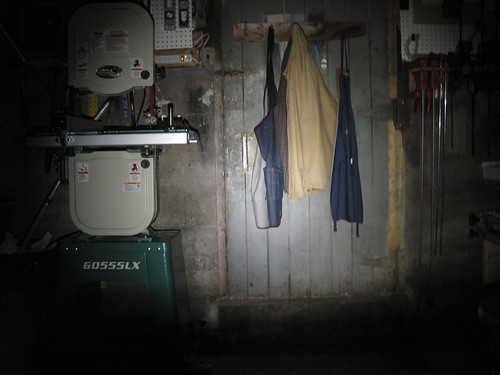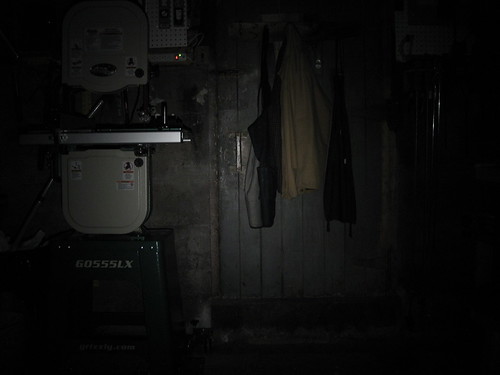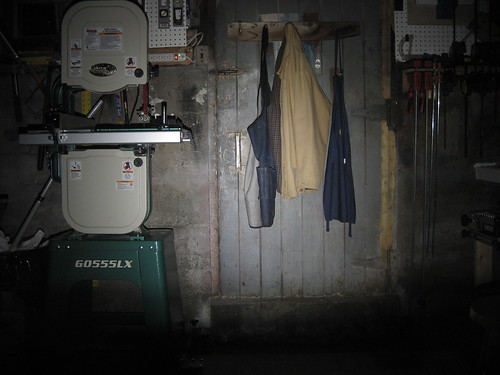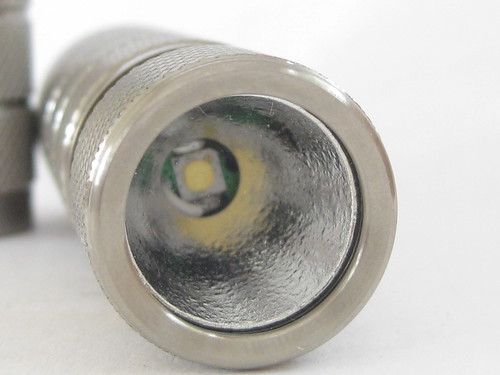Muyshondt Aeon and Nautilus Mk. II Review
This whole thing started for me when I found Doug P's (Quickbeam) old site flashlightreviews.com. There is so much information there, even in the archived site, that I still go back there and do research. The 5 star review system was brilliant--clear and simple. Doug's knowledge was impressive. But the thing that really stuck with me were his explanations of good design. Doug introduced me to the Flashlight Axiom, which, even today, all flashlight designs grapple with. The Flashlight Axiom, even almost a decade later, is still true. It says this:
Small Size, Long Runtimes, and High Output: Choose Two.
If you think about this, it brings out a fundamental tension in flashlight design, sort of like the balance of good steels (toughness, hardness, and corrosion resistance have an sort of internal push and pull equipoise as well). You can find lights that have a really great output and are small (the Peak Eiger, if it weren't infinite variable brightness), but don't run for a long time. You can have lights that have a high output and long runtimes but are really big (Fenix TK35). And you can find lights that have a good runtime, small size, but merely okay output. You will not find a light that is competitive in all three categories. It has a lot to do with battery chemistry, but there are other reasons as well. In the end, it is about making tradeoffs. What do you want to emphasize, given that you can't have it all?
I am not going to tell you that Aeon or Nautilus breaks Doug's Flashlight Axiom, but if I had to choose how to best balance out those three attributes it would look a lot like the Mk. II versions of the Aeon or Nautilus. This is not by accident. After I ran a piece about the Aeon going out of production, enough folks wrote me and asked if there was something I could do about it, I contacted Enrique (who is a super nice guy). We chatted and talked. We went back and forth on the ideal configuration of an Aeon and after some cajoling, he agreed to make a run with my requested features, if I could get 75 people to pledge. Given his reputation in the flashlight world that did not take long at all. Then it was just a matter of waiting.
About a month and half ago I got my Aeon Mk. II. Inside the package was a surprise. Unknown to most, Enrique also made a batch of Nautilus Mk. IIs as well. I got both to review and it has been one hell of a month, flashlight-wise. Given the fact that these were essentially made to my specifications, it is no surprise that I really like the lights. REALLY LIKE.
Here is the product page. Here and here are the posts that served as the kickoff for this project. The Aeon costs $425 from Enrique, though they may all be sold out. It was a run of 75. The Nautiluses are going on sale soon. There are no other reviews as I think I am the only person have used both lights other than the maker himself, but here is my review of the original Aeon and here is the Aeon Mk. II thread where you can read some of the specs. I emailed Enrique and he provided me some additional information, though he was careful to note that none of this data comes from an integrating sphere, so it is just a series of geusstimates: the low is around 3-5 lumens, the medium is close to the old low, around 30 lumens, and the high is around 110-115 lumens. The output is the same for both lights. Runtimes vary. Enrique has squeezed out a staggering 1 hour and 30 minutes for the high on the Aeon and 2 hours and 45 minutes for the Nautilus. Final specs will be added to this review when they are released.
Finally, here is a family portrait:
Design: Aeon: 2; Nautilus: 2
The Aeon Mk. II is an ideal EDC light--small enough to tuck in a coin pocket but with enough punch and versatility to cover just about any situation you would encounter. The Nautilus isn't a porker by any means, but the size increase doesn't do a whole lot for me. In the 1xCR123a class of lights the Nautilus is still among the smallest, but the increased runtime isn't enough to persuade me it is superior to the Aeon. In a vacuum, either is an excellent to superior light. Comparing one to the other, pure personal preference tells me I like the Aeon better. If you don't share that preference or if you only have the option to get the Nautilus, you will not be disappointed. It would be like having to "settle" for Rolex Deep Sea Dweller when you had your eye on the more svelte Submariner. Both are amazing, simple, straight forward, idiot proof designs.
The numbers are good with both, but better with the Aeon, obviously. I am going to hold off on actual ratios until the final lumens counts are done, but suffice to say the runtimes are insane, especially for the size and brightness (see above, Flashlight Axiom). Here is a shot of both next to the Zippo:
Mmmmm....shiny.
Fit and Finish: Aeon: 2; Nautilus: 2
There is no other way to describe these lights besides lush. The threads are silky smooth and get smoother by the day. The checkering is well cut with no errors I could see or feel. The tail end of the light is well cut even with the extensive machining. Enrique had a few delays because of machining issues, but the wait was worth it, these things are gems.
Of course the materials are of unsurpassed quality. The lens is sapphire, the body titanium, the heat sink brass, and the emitter my emitter of choice, the Nichia 219 HI CRI emitter. Everything is top shelf and made with superlative quality. Only the best of the best on both, hence a 2 for each. I'd give them a three if I could.
Grip: Aeon: 2; Nautilus: 2
The size on the Nautilus gives it a distinct advantage here. You don't need to any finger yoga to activate this thing one handed. It works quite well. The checkering on the bodies and heads of both lights is also excellent. The Aeon is not a slouch and again in a vacuum would score a 2, but I like the Nautilus a tad bit better here.
Carry: Aeon: 2; Nautilus: 2
I fell in love with the Aeon because of how nicely it carried. It almost completely disappears in your pocket. In jeans, the light vanishes. The size and shape are perfect--not so small as to be "unfindable" in a pocket, but small enough to essentially add nothing to what you already carry. This is one of the reasons this light is so amazing. The Nautilus is a little bigger, as you can see, but nothing crazy. It still rides well in coin pockets, but it is not quite as passive loose in a main pocket. Still very good though.
Output: Aeon: 2; Nautilus: 1
The output on both punches above its lumens rating because of the HI CRI emitter, but for the size, the Aeon is quite bright. The Nautilus faces incredibly stiff competition in the 1xCR123a market and the top end of roughly 110 lumens is not exactly tearing it up. It is more than sufficient for most EDC tasks, but compared to similar lights with the same power source it is just about par.
The low is the one area in which the Mk. II exceeds the older versions of Enrique's lights. The high and the low in the old lights were useful, but they lacked a true moonlight low. Here the low, the additional third mode, is perfect. It is not as low as some lights, my Steve Ku 40DD can get down to something like a half a lumen or less thanks to the QTC, but the low here is quite amazing.
The numbers, of course, don't tell the story. It is the actual light coming out the front of the torch that does that and in both cases it is quite good. Here are the beam shots:
Reference:
Aeon Mk. II
Low:
Medium:
High:
Nautilus Mk. II
Low:
Medium:
High:
Comparison (47s Penlight on high of 180 lumens):
The HI CRI output does a lot for both lights. The whites are pure and the off whites are noticeable (compare the off white cabinet of the band saw to the white of the peg board on the upper left of the picture). Notice the richer tan in the barn jacket and the redder reds on the clamp heads. Finally, notice how the green of the band saw stand seems to really stand out as green and not greenish blue as it appears on the Penlight beamshot. Even the concrete wall appears to have more texture and detail in the HI CRI shots of the Aeon and Nautilus. HI CRI does a lot to make the light more useful so both lights punch above their weight lumens-wise.
Runtime: Aeon: 2; Nautilus: 2
This is where Enrique laps the field. I owned the Mk. I Aeon for about three years and used exactly three batteries and the third one still had life left in it. The Nautilus's runtimes are even longer, at 2 hours and 45 minutes on high. The runtimes on low should be about a couple of days. Simply amazing.
Beam Type: Aeon 2; Nautilus: 2
Here is a shot down the barrel of the lumens cannon:
The beam, as you can see above, is a very floody beam with a mild hotspot and lots of spill, perfect for an EDC light. There is a better balance than the 47s Penlight which is also an EDC light but has virtually no hotspot at all. I like this balance a lot and it is a tribute to Enrique's design chops that this works as well as it does.
Beam Quality: Aeon: 2; Nautilus: 2
HI CRI, great emitter, wonderful reflector, and great lens equals a lush and beautiful beam. Frankly no other light I have owned or seen comes close. The Haiku has lost its crown as the highest quality beam available. The HI CRI Haiku that I gave away is probably an equal, but really nothing is better.
UI: Aeon: 2; Nautilus: 2
This is, perhaps, the best part of the light after the runtimes. Three modes could be finnicky, see all other twisty lights except for QTC lights. Instead we get the beauty of a three stage twisty in both lights. Twist, twist some more. That is all there is to operating this light. Simple, repeatable, easy to explain, and easy to use. BRILLIANT.
Hands Free: Aeon 2; Nautilus: 2
Both tailstand like they are nailed to a surface with no sway or wiggle. Both also fit nicely between the teeth, though again I don't recommend that. They are both a little roll happy, given that they lack clips but there are two spots that correspond to either gap in the rear tail portion that can hold the light in one place absent bonks or knocks. See below:
Overall Score:
20 out of 20 for the Aeon Mk.II with a PERFECT SCORE
19 out of 20 for the Nautilus Mk. II
The difference in the score comes down to the fact that the Nautilus's high is just not competitive with the best CR123a lights out there. The Aeon on the other hand has very little competition in the CR2 space, though it does lose to the 47s Mini CR2 (though the difference of 70 lumens is nothing like the difference between the Nautilus and the best 1xCR123a light, which is currently the LED Lenser F1 with 400 lumens on a single CR123a). The lumens counts could change a bit, but nothing enough to change the score.
Frankly, it would be silly for me to not give the Aeon a perfect score. After shameless begging Enrique agreed to make this light exactly as I had requested, the low low and the HI CRI emitter. This is as close as I will ever come to making a flashlight myself and given that, the Aeon deserves a perfect score. It is the best EDC light I have ever used or handled. It's fit and finish is equal to any light on the planet, its size, brightness and runtime are amazing, and the beam is simply jaw dropping. All of these things apply to the Nautilus too, but again, the competition is a bit stiffer in its product class.
Neither light is anything like a disappointment, but for me the miniaturization of the Aeon is a huge bonus. This is the new best light, cost no object. I'd love to get a review sample of a Spy 007, but even that light is a bit big for me. Unless you have some specific task, in my opinion, there is no better EDC light in the world than the Aeon Mark II.
Get one if you can.
Small Size, Long Runtimes, and High Output: Choose Two.
If you think about this, it brings out a fundamental tension in flashlight design, sort of like the balance of good steels (toughness, hardness, and corrosion resistance have an sort of internal push and pull equipoise as well). You can find lights that have a really great output and are small (the Peak Eiger, if it weren't infinite variable brightness), but don't run for a long time. You can have lights that have a high output and long runtimes but are really big (Fenix TK35). And you can find lights that have a good runtime, small size, but merely okay output. You will not find a light that is competitive in all three categories. It has a lot to do with battery chemistry, but there are other reasons as well. In the end, it is about making tradeoffs. What do you want to emphasize, given that you can't have it all?
I am not going to tell you that Aeon or Nautilus breaks Doug's Flashlight Axiom, but if I had to choose how to best balance out those three attributes it would look a lot like the Mk. II versions of the Aeon or Nautilus. This is not by accident. After I ran a piece about the Aeon going out of production, enough folks wrote me and asked if there was something I could do about it, I contacted Enrique (who is a super nice guy). We chatted and talked. We went back and forth on the ideal configuration of an Aeon and after some cajoling, he agreed to make a run with my requested features, if I could get 75 people to pledge. Given his reputation in the flashlight world that did not take long at all. Then it was just a matter of waiting.
About a month and half ago I got my Aeon Mk. II. Inside the package was a surprise. Unknown to most, Enrique also made a batch of Nautilus Mk. IIs as well. I got both to review and it has been one hell of a month, flashlight-wise. Given the fact that these were essentially made to my specifications, it is no surprise that I really like the lights. REALLY LIKE.
Here is the product page. Here and here are the posts that served as the kickoff for this project. The Aeon costs $425 from Enrique, though they may all be sold out. It was a run of 75. The Nautiluses are going on sale soon. There are no other reviews as I think I am the only person have used both lights other than the maker himself, but here is my review of the original Aeon and here is the Aeon Mk. II thread where you can read some of the specs. I emailed Enrique and he provided me some additional information, though he was careful to note that none of this data comes from an integrating sphere, so it is just a series of geusstimates: the low is around 3-5 lumens, the medium is close to the old low, around 30 lumens, and the high is around 110-115 lumens. The output is the same for both lights. Runtimes vary. Enrique has squeezed out a staggering 1 hour and 30 minutes for the high on the Aeon and 2 hours and 45 minutes for the Nautilus. Final specs will be added to this review when they are released.
Finally, here is a family portrait:
Design: Aeon: 2; Nautilus: 2
The Aeon Mk. II is an ideal EDC light--small enough to tuck in a coin pocket but with enough punch and versatility to cover just about any situation you would encounter. The Nautilus isn't a porker by any means, but the size increase doesn't do a whole lot for me. In the 1xCR123a class of lights the Nautilus is still among the smallest, but the increased runtime isn't enough to persuade me it is superior to the Aeon. In a vacuum, either is an excellent to superior light. Comparing one to the other, pure personal preference tells me I like the Aeon better. If you don't share that preference or if you only have the option to get the Nautilus, you will not be disappointed. It would be like having to "settle" for Rolex Deep Sea Dweller when you had your eye on the more svelte Submariner. Both are amazing, simple, straight forward, idiot proof designs.
The numbers are good with both, but better with the Aeon, obviously. I am going to hold off on actual ratios until the final lumens counts are done, but suffice to say the runtimes are insane, especially for the size and brightness (see above, Flashlight Axiom). Here is a shot of both next to the Zippo:
Mmmmm....shiny.
Fit and Finish: Aeon: 2; Nautilus: 2
There is no other way to describe these lights besides lush. The threads are silky smooth and get smoother by the day. The checkering is well cut with no errors I could see or feel. The tail end of the light is well cut even with the extensive machining. Enrique had a few delays because of machining issues, but the wait was worth it, these things are gems.
Of course the materials are of unsurpassed quality. The lens is sapphire, the body titanium, the heat sink brass, and the emitter my emitter of choice, the Nichia 219 HI CRI emitter. Everything is top shelf and made with superlative quality. Only the best of the best on both, hence a 2 for each. I'd give them a three if I could.
Grip: Aeon: 2; Nautilus: 2
The size on the Nautilus gives it a distinct advantage here. You don't need to any finger yoga to activate this thing one handed. It works quite well. The checkering on the bodies and heads of both lights is also excellent. The Aeon is not a slouch and again in a vacuum would score a 2, but I like the Nautilus a tad bit better here.
Carry: Aeon: 2; Nautilus: 2
I fell in love with the Aeon because of how nicely it carried. It almost completely disappears in your pocket. In jeans, the light vanishes. The size and shape are perfect--not so small as to be "unfindable" in a pocket, but small enough to essentially add nothing to what you already carry. This is one of the reasons this light is so amazing. The Nautilus is a little bigger, as you can see, but nothing crazy. It still rides well in coin pockets, but it is not quite as passive loose in a main pocket. Still very good though.
Output: Aeon: 2; Nautilus: 1
The output on both punches above its lumens rating because of the HI CRI emitter, but for the size, the Aeon is quite bright. The Nautilus faces incredibly stiff competition in the 1xCR123a market and the top end of roughly 110 lumens is not exactly tearing it up. It is more than sufficient for most EDC tasks, but compared to similar lights with the same power source it is just about par.
The low is the one area in which the Mk. II exceeds the older versions of Enrique's lights. The high and the low in the old lights were useful, but they lacked a true moonlight low. Here the low, the additional third mode, is perfect. It is not as low as some lights, my Steve Ku 40DD can get down to something like a half a lumen or less thanks to the QTC, but the low here is quite amazing.
The numbers, of course, don't tell the story. It is the actual light coming out the front of the torch that does that and in both cases it is quite good. Here are the beam shots:
Reference:
Aeon Mk. II
Low:
Medium:
High:
Nautilus Mk. II
Low:
Medium:
High:
Comparison (47s Penlight on high of 180 lumens):
The HI CRI output does a lot for both lights. The whites are pure and the off whites are noticeable (compare the off white cabinet of the band saw to the white of the peg board on the upper left of the picture). Notice the richer tan in the barn jacket and the redder reds on the clamp heads. Finally, notice how the green of the band saw stand seems to really stand out as green and not greenish blue as it appears on the Penlight beamshot. Even the concrete wall appears to have more texture and detail in the HI CRI shots of the Aeon and Nautilus. HI CRI does a lot to make the light more useful so both lights punch above their weight lumens-wise.
Runtime: Aeon: 2; Nautilus: 2
This is where Enrique laps the field. I owned the Mk. I Aeon for about three years and used exactly three batteries and the third one still had life left in it. The Nautilus's runtimes are even longer, at 2 hours and 45 minutes on high. The runtimes on low should be about a couple of days. Simply amazing.
Beam Type: Aeon 2; Nautilus: 2
Here is a shot down the barrel of the lumens cannon:
The beam, as you can see above, is a very floody beam with a mild hotspot and lots of spill, perfect for an EDC light. There is a better balance than the 47s Penlight which is also an EDC light but has virtually no hotspot at all. I like this balance a lot and it is a tribute to Enrique's design chops that this works as well as it does.
Beam Quality: Aeon: 2; Nautilus: 2
HI CRI, great emitter, wonderful reflector, and great lens equals a lush and beautiful beam. Frankly no other light I have owned or seen comes close. The Haiku has lost its crown as the highest quality beam available. The HI CRI Haiku that I gave away is probably an equal, but really nothing is better.
UI: Aeon: 2; Nautilus: 2
This is, perhaps, the best part of the light after the runtimes. Three modes could be finnicky, see all other twisty lights except for QTC lights. Instead we get the beauty of a three stage twisty in both lights. Twist, twist some more. That is all there is to operating this light. Simple, repeatable, easy to explain, and easy to use. BRILLIANT.
Hands Free: Aeon 2; Nautilus: 2
Both tailstand like they are nailed to a surface with no sway or wiggle. Both also fit nicely between the teeth, though again I don't recommend that. They are both a little roll happy, given that they lack clips but there are two spots that correspond to either gap in the rear tail portion that can hold the light in one place absent bonks or knocks. See below:
Overall Score:
20 out of 20 for the Aeon Mk.II with a PERFECT SCORE
19 out of 20 for the Nautilus Mk. II
The difference in the score comes down to the fact that the Nautilus's high is just not competitive with the best CR123a lights out there. The Aeon on the other hand has very little competition in the CR2 space, though it does lose to the 47s Mini CR2 (though the difference of 70 lumens is nothing like the difference between the Nautilus and the best 1xCR123a light, which is currently the LED Lenser F1 with 400 lumens on a single CR123a). The lumens counts could change a bit, but nothing enough to change the score.
Frankly, it would be silly for me to not give the Aeon a perfect score. After shameless begging Enrique agreed to make this light exactly as I had requested, the low low and the HI CRI emitter. This is as close as I will ever come to making a flashlight myself and given that, the Aeon deserves a perfect score. It is the best EDC light I have ever used or handled. It's fit and finish is equal to any light on the planet, its size, brightness and runtime are amazing, and the beam is simply jaw dropping. All of these things apply to the Nautilus too, but again, the competition is a bit stiffer in its product class.
Neither light is anything like a disappointment, but for me the miniaturization of the Aeon is a huge bonus. This is the new best light, cost no object. I'd love to get a review sample of a Spy 007, but even that light is a bit big for me. Unless you have some specific task, in my opinion, there is no better EDC light in the world than the Aeon Mark II.
Get one if you can.

